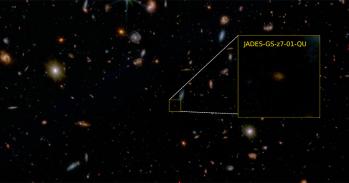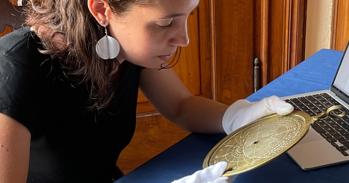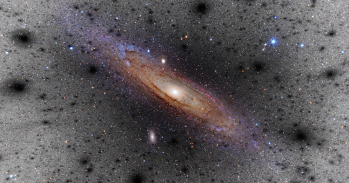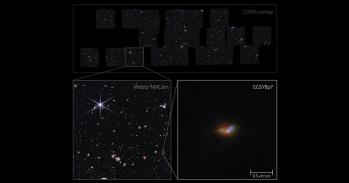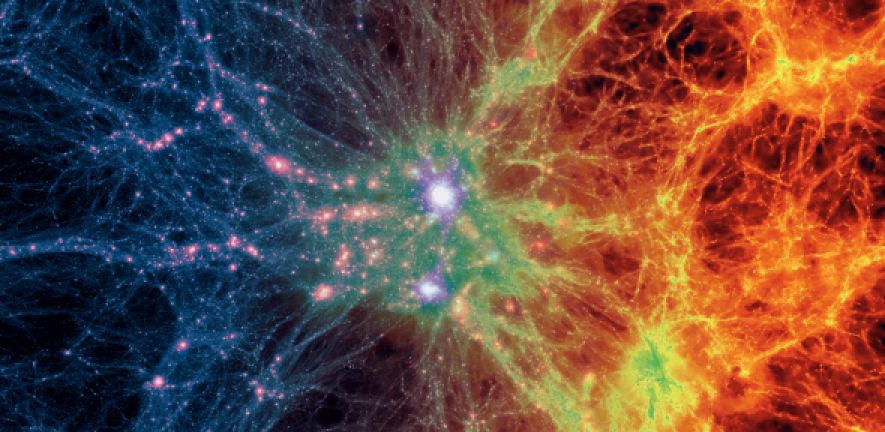
Astronomers have created the first realistic virtual simulation of the Universe, tracking 13 billion years of cosmic evolution.
Astronomers have created the first realistic virtual simulation of the Universe, tracking 13 billion years of cosmic evolution.
It shows us for the first time how the bewildering variety of galaxies and the supermassive black holes at their centres have formed
Dr Debora Sijacki
A newly-developed computer simulation has created the first realistic version of the Universe, enabling researchers to understand how galaxies, black holes and other cosmic phenomena evolved from early in the Universe’s development up to the present day.
The simulation, known as Illustris, follows the complex development of both normal and dark matter over 13 billion years, matching many of the features observed in the real Universe for the first time.
Developed by an international team of researchers, Illustris tracks the development of the Universe from 12 million years after the Big Bang up to the present, and identified more than 41,000 galaxies in a cube of simulated space 350 million light years on each side. The results are reported in the May 8th issue of the journal Nature.
Over the past two decades, researchers have been attempting to build accurate computer simulations of the development of the Universe, using computer programs which are capable of encapsulating all the relevant laws of physics governing the formation of galaxies.
Previous attempts to simulate the universe were hampered by lack of computing power and the complexities of the underlying physics. As a result those programs either were limited in resolution, or forced to focus on a small portion of the universe. Earlier simulations also had trouble modelling complex feedback from star formation, supernova explosions, and supermassive black holes.
Illustris employs a sophisticated computer program to recreate the evolution of the universe in high fidelity. It includes both normal matter and dark matter using 12 billion 3D “pixels,” or resolution elements.
Illustris yields a realistic mix of spiral galaxies like the Milky Way and giant elliptical galaxies. It also recreated large-scale structures like galaxy clusters and the bubbles and voids of the cosmic web.
The team dedicated five years to developing the Illustris project. The actual calculations took three months of run time, using a total of 8,000 CPUs running in parallel. In comparison, the same calculations would have taken an average desktop computer more than 2,000 years to complete.
“Until now, no single simulation was able to reproduce the Universe on both large and small scales simultaneously,” says lead author Dr Mark Vogelsberger of the Massachusetts Institute of Technology and Harvard University, who conducted the work in collaboration with researchers at the University of Cambridge, the Harvard-Smithsonian Center for Astrophysics and the Heidelberg Institute for Theoretical Studies.
“The Illustris simulation is a remarkable technical achievement,” said Dr Debora Sijacki of Cambridge’s Institute of Astronomy, one of the paper’s co-authors. “It shows us for the first time how the bewildering variety of galaxies and the supermassive black holes at their centres have formed.”
Since light travels at a fixed speed, the farther away astronomers look, the farther back in time they can see. A galaxy one billion light-years away is seen as it was a billion years ago. Telescopes like Hubble can give us views of the early Universe by looking to greater distances. However, astronomers can’t use Hubble to follow the evolution of a single galaxy over time.
“Illustris is like a time machine. We can go forward and backward in time. We can pause the simulation and zoom into a single galaxy or galaxy cluster to see what’s really going on,” said co-author Dr Shy Genel of Harvard University.
A selection of videos and imagery from the project are available online at www.illustris-project.org.
Story adapted from Harvard-Smithsonian Center for Astrophysics press release.
The text in this work is licensed under a Creative Commons Licence. If you use this content on your site please link back to this page. For image rights, please see the credits associated with each individual image.


